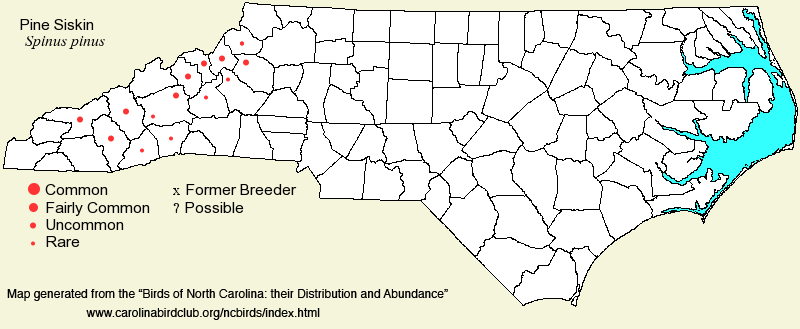 |  |
|
Pine Siskin - Spinus pinus FRINGILLIDAE Members: | Search Common: Search Scientific: |
|
|
|||||||
| General Comments | The Pine Siskin is another "winter finch", but like the Red Crossbill, it also nests in the North Carolina mountains. However, the great majority of the species nests in the boreal forest zone of Canada and the western United States. Relatively few birds nest down the Appalachian Mountain chain, and it was not until a few decades ago that breeding in the state was actually confirmed, though siskins were assumed to nest all through the 20th Century. Away from the spruce-fir zone in the state, where the birds nest, siskins occur somewhere downstate in most winters, sometimes being fairly common to common, but in recent years typically being rare or uncommon. Wintering numbers are considerably down from the large invasions seen in the South back in the 1960's and 1970's. A major invasion reached the state in fall and winter 2020-21. Siskins can be seen in pure flocks, or in flocks of American Goldfinches or occasionally sparrows, House Finches, or Purple Finches. They can be seen in various forests and woodlands (especially feeding in Sweetgum trees), in alder stands along creeks and lake shores, and occasionally in weedy fields, though they tend to stay closer to wooded cover than do the goldfinches. Siskins also visit bird feeders, sometimes in numbers of several dozen birds. | ||||||
| Breeding Status | Breeder | ||||||
| NC BRC List | Definitive | ||||||
| State Status | W | ||||||
| U.S. Status | |||||||
| State Rank | S1B,S3N | ||||||
| Global Rank | G5 | ||||||
| Coastal Plain | Winter visitor, erratic from season to season; declining. Currently, very rare to rare in some seasons, and locally fairly common in others; several decades ago was common in a few winters. More frequent in the northern portion than the southern portion. Mainly mid-Oct to late Apr. One at a feeder in Nags Head (Dare) on 4 Jul 2021 was quite out of season. Peak counts: | ||||||
| Piedmont | Winter visitor, erratic from season to season, declining; apparently an accidental breeder. Currently, rare to at times fairly common; can be nearly absent in a few winters. At times, common in winter in the 1960's and 1970's, but seldom common in recent years. A surprising record is of two adults discovered feeding two fledglings at Durant Nature Park, Raleigh, in a stand of Shortleaf Pines, on 30 May 2009. Also, an adult was seen feeding a juvenile in Chapel Hill (Orange) on 13 May 2019, suggestive of breeding but perhaps not conclusive. Mainly late Oct or early Nov to late Apr; however, many records of lingering birds into Jun and early Jul. Peak counts: 598, Jordan Lake CBC, 4 Jan 2009; 560, Durham CBC, 16 Dec 2012; 558, Chapel Hill CBC, 23 Dec 2012; 300-400, Bakers Mountain Park (Catawba), 13 Jan 2009. | ||||||
| Mountains | Summer resident at higher elevations, and winter visitor elsewhere (but erratic and declining). In summer, uncommon and somewhat erratic at higher elevations (mainly over 4,500 feet) in the spruce-fir zone; very rare lower. At other seasons, can be rare in some winters and fairly common to at times common in others, but not as numerous as several decades ago, when at times it was quite common. Peak counts: 1,000, Graham, 27 Nov 1981; 500 at Mount Mitchell SP (Yancey), 24 Oct 2020; 500 at feeders at Snowbird Mountain Lodge (Graham), 24 Apr 2016; 325, Cashiers (Jackson), 27 Oct 1985. | ||||||
| Finding Tips |
Your best bet is to bird the spruce-fir forests, such as Roan Mountain, Mount Mitchell, or in the Devils Courthouse area, in summer. Getting good views of perched birds can be tricky, and most birds are seen and heard in flight. ** | ||||||
| Attribution | LeGrand[2023-03-28], LeGrand[2021-11-07], LeGrand[2021-08-04] | ||||||
| NC Map Map depicts all counties with a report (transient or resident) for the species. | Click on county for list of all known species. |
| NC Breeding Season Map Map depicts assumed breeding season abundance for the species. |  |